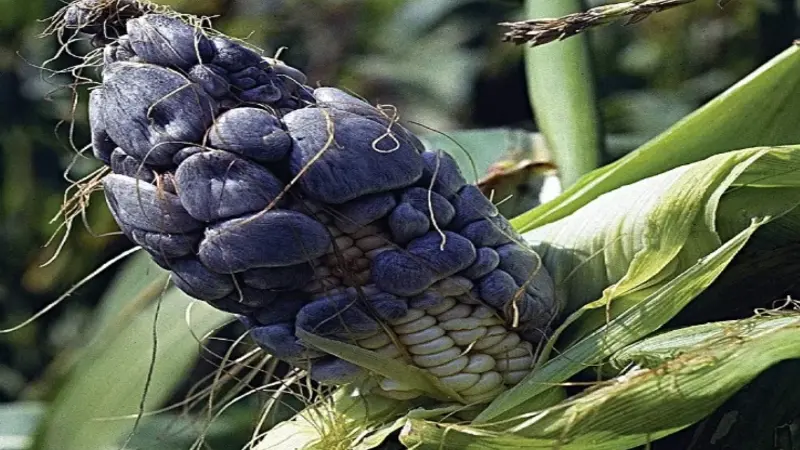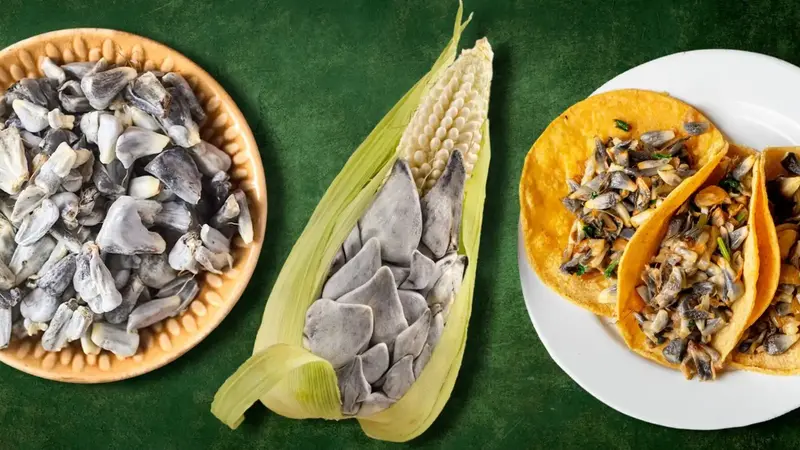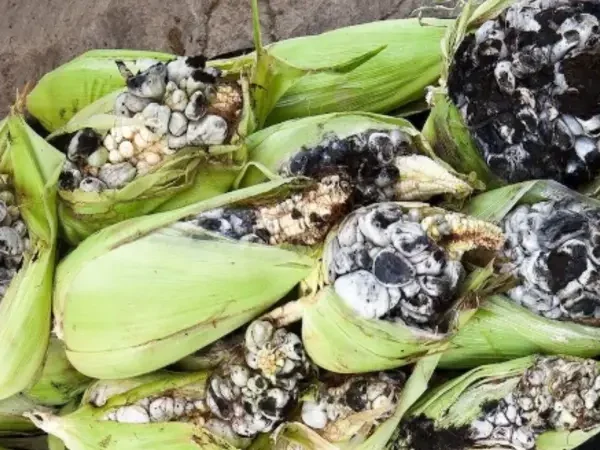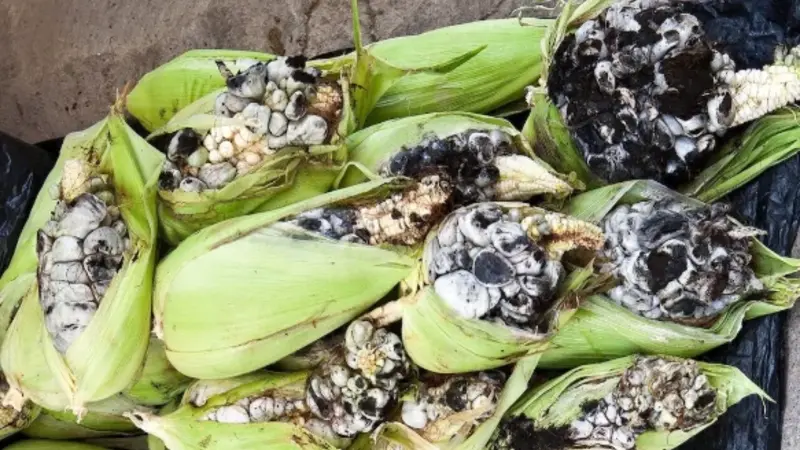Trending Posts
Huitlacoche: Debunking the Myth Why This Delicacy is…
Huitlacoche (pronounced weet-la-KOH-cheh), the prized “Mexican truffle” or “Aztec caviar,” is a celebrated ingredient in Mexican cuisine, valued for…
The Fascinating World of Huitlacoche: Mexico’s Hidden Culinary…
Introduction to Huitlacoche If you have ever tasted authentic Mexican street food, you may have come across a…
Huitlacoche: The Mexican Corn Truffle You Need to Try Meaning, Recipes & Culture

No doubt, the term huitlacoche may sound weird and even disgusting to someone who has never been through the adaptation process of the Mexican food’s tastes and flavors. Nonetheless, it is a term that, in some way, uncovers one of the greatest advantages of Mexican gastronomy. This odd fungus, with the scientific designation Ustilago maydis and called Mexican truffle or corn smut, is appreciated for its strong, earth-like odor and peculiar flavor. Its flavor is not the only quality that makes it exceptional. It also has cultural and historical importance, as it has been used from the time of the. Aztecs to the present-day chef’s kitchen, representing the past, the present, and the future of gourmet food through culture, creativity, and the skill of making bizarre nature products edible and tasty.
What Is Huitlacoche?
The sole variety of mushrooms that can be consumed and is commonly referred to as huitlacoche (diapason wee-tlah-KOH-cheh) is the one that parasitizes the maize plants, takes the original hue of the grains by turning them gray, and gives off the smell of soil simultaneously. The fungus’s looks may not be too lovable, but its taste has been its plus point, and the fungus has been the reason for its being a delicacy in Mexican food for around three hundred years.
The taste is very difficult to explain; it consists of sugar, smoke, and saltiness combined. Therefore, it can be matched with cheese, corn, and chili peppers. This has been so consistent that this ingredient has finally become simultaneously a part of both Mexican dining and the worldwide kitchen.
What Does Huitlacoche Taste Like?
Huitlacoche, often called by various names as a Mexican truffle, is a remarkable and odd fungus having a scent close to that of a forest, mixed with slight gaminess and sweetness. What a delightful smell it is, mainly characterized by roasted corn and mushrooms combined, which results in a beautiful and pleasant smell.
Also, it disappears and turns into a rich creamy texture during warming, thereby facilitating blending with various kinds of meals. It has been a fundamental food in Mexico for tacos, soup, and quesadilla making, and even all over the world. By now, you know we should give developers some insight.
The Meaning and Cultural Significance of Huitlacoche
Huitlacoche originates from the Nahuatl word cuitlacochin, which has two meanings, namely the poop of a raven and the deceased excrement, giving a clue to the saprophytic nature of the fungus; consequently, the origin of the name. For the Aztecs, it was not only food but also a divine thing that represented wealth and change. They even took it for its therapeutic and restorative properties. Nowadays, huitlacoche has come to be a strong representative of Mexico’s great nature appreciation and its talent for converting flaws into magnificence.
Is Huitlacoche an Animal or a Plant? The Huitlacoche Animal Confusion
A frequent query that pops up on the internet is whether huitlacoche is an animal. The ambiguity is because huitlacoche is the name of one of Mexico’s birds, a thrasher with a beautiful song, in fact, among other things. Nevertheless, if it is about huitlacoche in terms of food, then it is not at all the case of being connected with animals. It is, however, not a bird but a fungus that affects maize. The misunderstanding in pronunciation is merely a coincidence that occasionally results in funny misunderstandings of meanings for those who do not speak Spanish.
Therefore, to make it clear:
Huitlacoche food: Edible corn fungus, a professional delicacy.
Huitlacoche monster: Aerial type, no less a fungus to be called a tasty one.
Again, the definitions vary when applied to, and a step-by-step discussion of this issue is necessary.
From Street Stalls to Fine Dining: The Rise of Huitlacoche

The edible Mexican fungus, huitlacoche or mushroom, has been one of the most versatile ingredients in many food products, from street vendors to the most exquisite restaurants. With its bold, mushroom-like flavor with hints of smoke and sweetness, it can be used as an ingredient in numerous types of dishes with no difficulty at all.
For example, the most common use is in quesadillas, tamales, and soups, but it is also done in making risottos, pastas, and gourmet tacos by modern chefs, thus mixing the old with the new. Fresh huitlacoche is offered during the corn harvest season only, while canned or frozen versions are available all year round in Latin markets around the world.
The Famous Huitlacoche Quesadilla
The most traditional quesadilla is the least sophisticated and the best-tasting way to treat oneself with huitlacoche. This adored street food directly reflects the core of Mexican comfort very few ingredients but a very strong flavor. The most common huitlacoche quesadilla consists of raw huitlacoche, mixed cheese of Oaxaca or Chihuahua, and a corn tortilla made by hand.
There are some more options of cooking which include the use of onion, garlic, and epazote, a highly fragrant herb that makes the already earthy taste stronger. When done on a comal griddle, the hidden treasure of a crispy tortilla stuffed with brilliantly melting cheese and incredibly tasty huitlacoche is brought out red or green salsa becomes a perfect partner for this delight.
Huitlacoche Recipe: Gourmet Corn Truffle Tacos
In case you want to treat yourself with a finer version of the huitlacoche recipe, give a try to this very uncomplicated gourmet taco recipe.
Ingredients:
- 2 cups huitlacoche
- 2 tbsp butter
- 1 small shallot, minced
- 1 jalapeno, chopped
- ½ cup sweet corn kernels
- ¼ cup heavy cream
- 1 tsp lime juice
- Salt and pepper
- 8 small corn tortillas
- Queso fresco and cilantro for garnish
Instructions:
- The procedure is nothing but melting some butter on medium heat in order to warm the pan.
- Later, the shallots and jalapeno will be combined, and the cooking will stop when a nice aroma starts coming out.
- Five minutes will be the time for cooking the combined huitlacoche and corn.
- The emulsion that will be prepared will have three main components: cream, seasoning, and lime juice.
- The extremely hot melted cheese will be poured over the tortillas, and cilantro will be sprinkled on top.
There is an amazing combination of flavors: earthy, creamy, and sour, a real Mexican delight.
Preserving by Freezing or Drying
The freezing or drying method, in fact, retains the longest fruit, vegetable, and meat nutrients besides being the best. The storage time for such food is, for freezing, six months because it stops the growth of bacteria and the activity of enzymes. On the opposite side, drying removes the water in a ratio where it is impossible for bacteria and insects to invade the product.
This method is top-notch for seasoning with herbs, fruits, and the manufacturing of meat products such as jerky. Both methods are similar in that they minimize waste to the fullest extent and provide the buyer with a steady supply of seasonal products all year round.
Nutritional Benefits of Huitlacoche
Huitlacoche is the fungus that is both a luxury and a superfood at the same time, as it is a protein, fiber, and major minerals such as magnesium, calcium, and phosphorus, rich food. It is also very low in amino acids, one of which is lysine. Therefore, it helps to maintain the nutritional value in corn-based diets.
Also, its high antioxidant and beta-glucan content make it an excellent supporter of the immune system and good health in general. The distinct umami taste of this fungus not only gives it a fascinating character when added to different dishes but also provides sustenance. Consequently, it is an excellent and savory option for both vegetarians and vegans at the same time.
How to Cook and Store Huitlacoche
Huitlacoche is a mushroom-like fungus with a flavor that is often compared to that of mushrooms and, therefore, is found in many cuisines where it is either the main or the desired ingredient. If it has to be fresh, it has to be chilled and eaten within 2 to 3 days. Before cooking, it must be briefly sprayed under cold water first, then over the stove, along with the onion, garlic, or butter, until it becomes tender and tastes good.
It will not be long on the fire, or it will get dry or hard. Therefore, it will lose its taste and softness. Fortunately, canned or frozen huitlacoche is available year. Thus, it is possible to incorporate it in all kinds of culinary preparations, like soups, sauces, and quesadillas, and can also be a fresh mushroom substitute when the latter are not available due to their non-growing season.
Cultural Rebirth: From Crop Disease to Culinary Jewel
Initially considered a corn disease, huitlacoche has grown gourmet in the list of Mexican ingredients, at the top of the range, with its rich, truffle-like flavor. Its worth has already been recognized at fine-dining restaurants in Mexico City, New York, and Paris, and it has been added to their menus.
The renowned chefs Enrique Olvera and Rick Bayless have received global recognition through their modern cuisine for this ingredient. They have turned it from one of nature’s oddities into a hallmark of Mexican culinary prestige and inventiveness by blending the old with the new.
Huitlacoche Beyond Borders
The universal fame of huitlacoche is still increasing with the increase in the number of people who search for sustainable and different ingredients. Its bold taste, together with its exceptional nutritional value, has turned it into a world-renowned ingredient for vegetarian dishes, for high-end restaurants, and even for meat besides. What was once a Mexican secret has now been acknowledged by culinary masters and food lovers around the globe for its compatibility with other components and its richness of flavor.
It is not considered only a kitchen product; it is being researched for its possible role as an eco-friendly food source. The fact that it naturally increases the protein content of corn makes it a candidate for the global nutrition problem. This peculiar fungus is likely to become a crucial part of agricultural future innovation and sustainable food technology soon.
Trying Huitlacoche for the First Time
In case of occasion, you might be wondering what to do with huitlacoche. In case you want a recommendation, the basic forms, such as tacos or quesadillas, are without any doubt the top choices for you. The mixture of steaming and tender tortillas with the oozing cheese and rich filling gives rise to a flavor that is calming and at the same time invigorating. Next, once you have acquainted yourself with the flavor, you can treat yourself to the more elegant plates, such as risotto or soup, which contain the basic taste and are supposed to take you through the whole richness.
Huitlacoche, taken from the plant, is picked together with the corn. Mexico, thus, its a delicate flavor makes it very popular. Outside of Mexico, Latin grocery shops cast their nets for canned and frozen variants, which are wonderful for those who want to take a bite out of the unique delicacy throughout the year.
Conclusion
Huitlacoche is not simply a condiment; it is the very embodiment of change, imagination, and cultural glory. It was initially thought of as a worthless corn pest but has now become a symbol of Mexico’s toughness and the world’s best chefs. The road taken from field fungus to gourmet delicacy is truly remarkable and also speaks of the country’s ability to spot value and beauty in nature’s surprises. Be it melted in a steaming quesadilla or in a finely crafted taco or while listening to la boda del huitlacoche letra as you prepare, it would still give you a feel of the.
Mexican culture is in your mouth with every bite. One might say that every dish has its own tale, which has been retold countless times, thus bringing to our minds that the most exquisite taste can occasionally emanate from the least expected places. Huitlacoche is not only a cultural, historical, and gastronomic transformation in a simple and loud way, but it is also a total and very loud celebration of the same.


